|
1970 Chrysler 300 HURST |
|
After an absence of four years, there was again a full-size Chrysler muscle car in 1970. Although not really a letter car, the Chrysler 300 Hurst was a special model and is seen today as a legitimate member of this elite circle. Chrysler also wanted the car to be seen like this when it was introduced, as the 300 Hurst owner's booklet proves. At that time, the still independent Hurst Company not only manufactured shifters but was also eager designing special sports car concepts based on regular production cars. Many of the concepts were never realized, but this particular design seems to have convinced some brass at the Chrysler Division. The reason there were only 485 or maybe 500 cars built was that the approval came well after the regular 1970 Chryslers were already in production. Therefore it was a scramble to get the Hursts made. Much worse, Chrysler thought Hurst would promote the model and Hurst assumed Chrysler would. As a result, most dealers didn't know much if anything about them until one showed up on a carrier in their lot. Probably only a few were actually ordered, just "appeared" in the dealer's driveway. The cars were run through the Chrysler plant on Jefferson Avenue in batches, as two door hardtops in Spinnaker-White. They had Imperial leather interiors in "Saddle" color installed as they went down the Chrysler line. They were then sent to Warminster, PA, where Hurst did the conversions. Originally, the cars were to get deeper oil pans, special ignition systems and of course, Hurst shifters. However, none of that was realized. So against popular belief, the cars don't have a Hurst shifter. What Hurst actually did was to cut off the sheetmetal hood skin and replace it with a fiberglass part. Then they installed the fiberglass trunklid plus rear fender end caps and painted the car in the one available color scheme. What appears to be gold color is actually "Satin Tan" which graced the hood, trunk and a beltline streak (this also explaines why the interior was in tan and not in gold, which would have been feasible). Where Satin Tan and white bordered, a brown-orange-brown decal stripe could be seen. This stripe also found its way on the lower body side. The fiberglass hood had a non-functional power bulge scoop (with a "300-H" emblem on either side) and functional recessed twist locks. The decklid featured an incorporated rear spoiler and no trunk lock. This required the vacuum remote trunk lock as standard, operated from the dashboard, in the glove compartment. It was accompanied by a cable operated emergency unit under the dash. Some of the rear spoilers were misused as a lid handle or otherwise sustained structural deficencies, so Chrysler dealers offered support blocks sandwiched between spoiler and lid. Those can be seen on some of the existing models. The whole package left room for some additional options, but most characteristics could not be altered. Almost all of the 300-Hursts feature power windows and one is known to have come with a sunroof. The steel road wheels were also part of the deal. However, they didn't come all chromed but were painted Satin Tan color and had decals applied along with the stripes in brown and orange. The regular 300 grille with hidden headlights sported orange instead of red accent paint stripes. No vinyl tops could be ordered. In the back, square bright tip exhausts were optional. Under the hood, the 440 cui. HP "TNT" engine with 375 gross horsepower served as a powerplant. This engine was also optional in other Chryslers. It breathed through a dual snorkel air cleaner, roared through dual exhausts and required a beefed up TorqueFlite transmission. No other powertrain was available. Ride was enhanced with a firm suspension due to tougher rear leaf springs and larger diameter torsion bars up front (this suspension was also available to other Chrysler models as part of the trailer-towing package). Power front disc brakes were standard, as was the 3.23:1 final drive ratio. Inside reigned a unique combination. The interior came in "Saddle" (tan) with leather seats, the same that were optional in 1970 Imperial LeBaron two-door hardtops. The front saw power bucket seats with center seat cushion. The rest of the interior was the regular Chrysler 300 dress-up. Column-shift A/T was standard while the Chrysler console with gear selector was optional and would replace the center seat cushion with armrest. A Tilt-and-Telescope steering wheel was another option, like the choice of one of the air conditioning systems. The 1970 Chrysler 300 Hurst saw between 485 and 500 copies, experts are not sure. This Chrysler Corp. letter from 1972 states the smaller figure. Two additional convertibles are said to be made, one of which is probably seen in the picture further below. With an MSRP of $ 5,939.00 without optional equipment, the 1970 Chrysler 300 Hurst was the most expensive Chrysler in 1970 (except Imperials). |
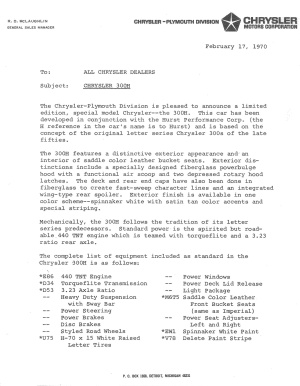
|
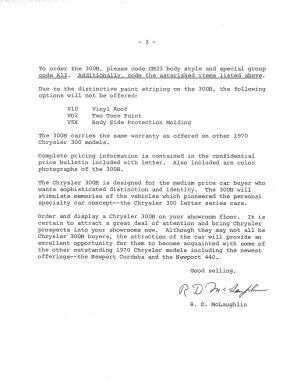
|

|
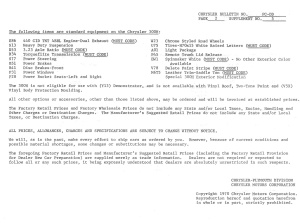
|
|
1970 Chrysler 300 Hurst Dealer Bulletin and Price Info |
|
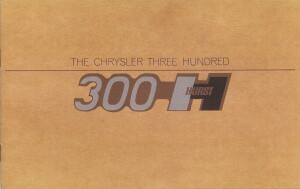 1970 Chrysler 300 Hurst Owner's Booklet (click to browse) |
|
|
|
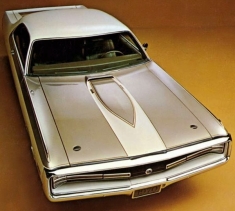 Front |
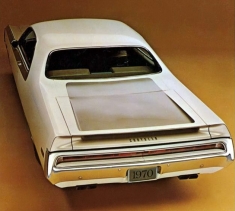 Rear |
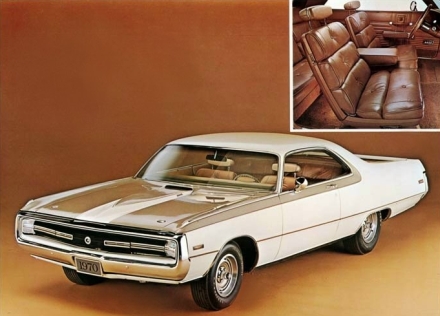 Exterior and Interior |
|
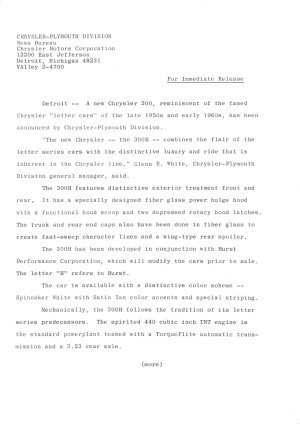
|
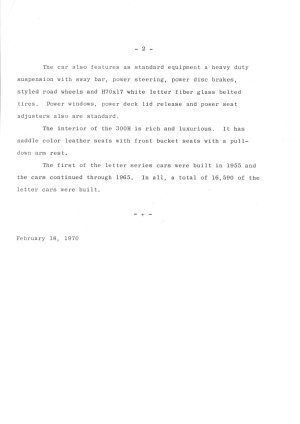
|
|
1970 Chrysler 300 Hurst Press Release |
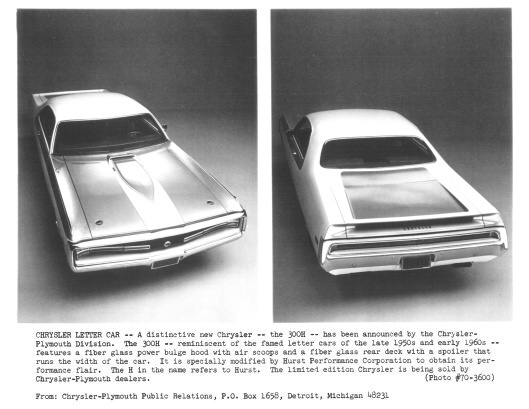 Chrysler 300 Hurst Press Photo |
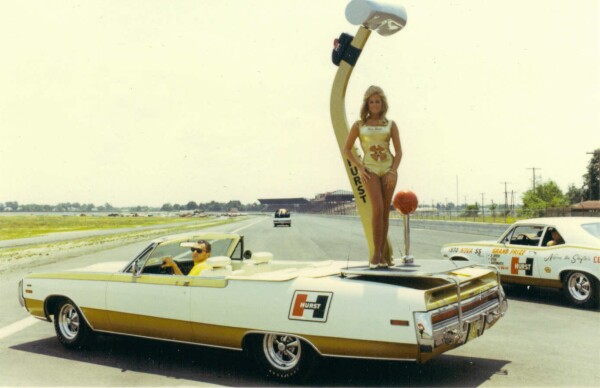 1970 Chrysler 300 Hurst convertible serving as Hurst shifter parade float, featuring then Miss Hurst, Linda Vaughn. Location is probably old Riverside race track. Thanks to Doug Backstrom. |
|
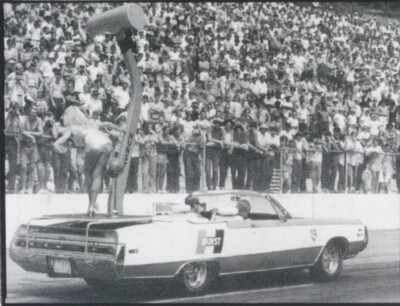 Another shot of the same car and model team in action. |
|
|
If you have other original Hurst material, please let me know!! Thank you, Jack, for the color images on this side. Thanks to Joe Gross for the letter and owner's booklet. Thanks to Klaus Koppenhagen for the press release photograph. Thanks to Ray Jones for his valuable contributions! |
|
|
1970 Chrysler Main Home |